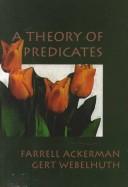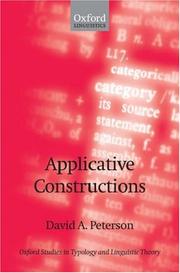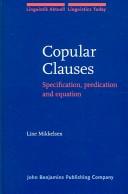| Listing 1 - 10 of 128 | << page >> |
Sort by
|

ISBN: 1575860864 Year: 1997 Publisher: Stanford, Calif.
Abstract | Keywords | Export | Availability | Bookmark
 Loading...
Loading...Choose an application
- Reference Manager
- EndNote
- RefWorks (Direct export to RefWorks)
Grammar --- Grammar, Comparative and general --- Predicate (Grammar) --- Verb phrase --- Phrasal verb --- Predicate --- Verbals --- Verb phrase. --- Linguistics --- Philology
Book
ISBN: 9789027255563 9789027287250 9027287252 128297680X 9781282976801 9027255563 9786612976803 Year: 2011 Publisher: Amsterdam Philadelphia John Benjamins Pub. Co.
Abstract | Keywords | Export | Availability | Bookmark
 Loading...
Loading...Choose an application
- Reference Manager
- EndNote
- RefWorks (Direct export to RefWorks)
This research monograph is an empirical and theoretical study of clause-final verbal complexes in the history of German. The book presents corpus studies of Middle High German and Early New High German and surveys of contemporary varieties of German. These investigations of the verbal complex address not only the frequencies of the word orders, but also the linguistic factors that influence them. On that empirical basis, the analysis adopted is the classic verb-final approach, with alternative orders derived by Verb (Projection) Raising.
German language --- Grammar, Comparative and general --- Syntax. --- Verb phrase. --- Predicate (Grammar) --- Verb phrase --- Phrasal verb --- Predicate --- Verbals --- Linguistics --- Philology
Book

ISBN: 1282196928 9786612196928 3110207842 9783110207842 3110198657 9783110198652 9781282196926 9783110198652 Year: 2008 Publisher: Berlin Boston
Abstract | Keywords | Export | Availability | Bookmark
 Loading...
Loading...Choose an application
- Reference Manager
- EndNote
- RefWorks (Direct export to RefWorks)
This volume addresses the constructional variability with transitive and causative verbs from the point of view of their respective action and motion patterns. Drawing on the theoretical advances registered in cognitive approaches to language (Cognitive Grammar, Construction Grammar and space semantics), the papers substantiate new interpretations and adduce empirical evidence from various languages to refine or adjust existing analyses of transitivity and causation. The different contributions all address the crucial question of how concrete and abstract notions of human behavior drive linguistic expressions. Cognitive linguists consider that linguistic competence functions in terms of complex conceptual units: the native speaker knows and manipulates conceptual blocks without paying further attention to their constitutive parts or their internal organization. However, as this volume illustrates, the role of the constitutive parts and their internal organization cannot simply be reduced to zero. A multidimensional approach to construction schemas is at stake. That is, the speaker applies proper embodied subroutines to build a coherent meaning, but the construction schemas are also rooted in the linguistic patterns the speaker and hearer are familiar with. The volume is primarily intended for scholars working within cognitive-semantic research at large. Given its theoretical and applied character (in the sense of giving empirical evidence for specific problems in the grammar), the volume will also be of great interest to anyone concerned with syntactic processes, construction grammar or with the cognitive structure of discourse. The descriptive and theoretical insights indeed dwell on areas that are currently dealt with in modern linguistics.
Grammar, Comparative and general --- Predicate (Grammar) --- Verb phrase --- Verb phrase. --- Phrasal verb --- Predicate --- Verbals --- Linguistics --- Philology --- Cognitive Linguistics. --- Semantics.
Book
ISBN: 9789048185498 9789048185504 9789048185511 9789400732162 9048185491 9786613002983 9048185505 1280002700 Year: 2010 Publisher: Dordrecht Springer Netherlands
Abstract | Keywords | Export | Availability | Bookmark
 Loading...
Loading...Choose an application
- Reference Manager
- EndNote
- RefWorks (Direct export to RefWorks)
This monograph probes the structure of the verb phrase through a cross-linguistic investigation of the syntax and morphology of relevant constructions. In particular, the author provides evidence for two event-related non-lexical projections called "inner aspect" and "event". The former is found within the verb phrase and encodes information on the endpoint of an event. The latter is found at the edge of the verb phrase and demarcates the boundary of a particular domain of syntax, L-syntax. Although languages vary in their use of these projections and in the way they encode the endpoints of events, the author argues that the comparison of a number of languages and the analysis of a range of constructions results in the emergence of a consistent picture. While much of the discussion involves Austronesian languages such as Malagasy and Tagalog, other languages such as French, Spanish, Swedish, Scots Gaelic, Chinese, Japanese, Navajo, Slave, and Kalagan are discussed. Syntactic and morphological data from these languages are used to illuminate the details of the phrase structure of the verbal predicate. These data also aid in understanding how phrase structure is used to express certain facets of language, such as event structure, aspectual verb classes, productive and lexical causatives, derived objects, agents and causes, and coerced structures.
Lexicology. Semantics --- Phonetics --- Grammar --- Grammar, Comparative and general --- Verb phrase. --- Austronesian languages --- Malay-Polynesian languages --- Malayo-Polynesian languages --- Predicate (Grammar) --- Verb phrase --- Phrasal verb --- Predicate --- Verbals --- Linguistics --- Philology
Book
ISBN: 9783110198652 3110198657 Year: 2007 Volume: 198 Publisher: Berlin Mouton de Gruyter
Abstract | Keywords | Export | Availability | Bookmark
 Loading...
Loading...Choose an application
- Reference Manager
- EndNote
- RefWorks (Direct export to RefWorks)
Grammar --- Grammar, Comparative and general --- Syntagme verbal --- Verb phrase. --- Verb phrase --- Academic collection --- Predicate (Grammar) --- Phrasal verb --- Predicate --- Verbals --- Linguistics --- Philology --- Grammar, Comparative and general - Verb phrase
Book
ISBN: 3961100837 3961100845 9783961100835 9783961100842 Year: 2018 Publisher: Language Science Press
Abstract | Keywords | Export | Availability | Bookmark
 Loading...
Loading...Choose an application
- Reference Manager
- EndNote
- RefWorks (Direct export to RefWorks)
Author(s)Bacskai-Atkari, JuliaCollectionKnowledge Unlatched (KU)LanguageEnglishShow full item recordThis book provides a new analysis for the syntax of comparatives, focusing on various deletion phenomena affecting the subclause. In particular, the proposed account shows that Comparative Deletion is merely a surface phenomenon that can be drawn back to the overtness of the comparative operator and the availability of lower copies of a movement chain, and it is thus subject to both language-internal and cross-linguistic variation. The main focus of the book is on English, yet other languages are also discussed for comparative purposes, with the aim of showing what the idiosyncratic properties of English comparatives are.
Inglés --- English language --- Deletion. --- Syntax --- Germanic languages --- Linguistics --- Adjective --- Ellipsis --- Hungarian language --- Lexical verb --- Polish language --- Predicate (grammar) --- Specifier (linguistics) --- Verb --- Verb phrase ellipsis
Book
ISBN: 1575860341 Year: 1996 Publisher: Stanford, Calif. Center for the Study of Language and Information
Abstract | Keywords | Export | Availability | Bookmark
 Loading...
Loading...Choose an application
- Reference Manager
- EndNote
- RefWorks (Direct export to RefWorks)
Romance languages --- Grammar --- Grammar, Comparative and general --- Syntax. --- Verb phrase. --- Predicate (Grammar) --- Verb phrase --- Language and languages --- Syntax --- Phrasal verb --- Predicate --- Verbals --- Linguistics --- Philology --- Grammar, Comparative and general Syntax
Book
ISSN: 00924563 ISBN: 9789004306981 9789004307094 9004307095 9004306986 Year: 2016 Volume: 41 Publisher: Leiden Brill
Abstract | Keywords | Export | Availability | Bookmark
 Loading...
Loading...Choose an application
- Reference Manager
- EndNote
- RefWorks (Direct export to RefWorks)
Complex predicates can be loosely defined as a sequence of items that behave as a single predicate, projecting a single argument structure within a clause. Each of the members of the predicate contributes part of the information ordinarily associated with a single head. The present volume presents a collection of theoretical linguistic results on the study of complex predicates in different perspectives and with a variety of approaches. Important empirical and theoretical issues cutting across various subfields of linguistics are being addressed in this book, such as : • Syntactic and semantic modeling of complex predicate formation: compositionality, argument structure, event structure. • Differences between syntactic and morphological processes of lexeme formation. • Typological and diachronic issues in complex predicate formation. • Neo-Davidsonian analyses of abstract predicate decomposition and its morphological correlates Contributors are: Ane Berro, Denis Creissels, Hannah Gibson, Adele Goldberg, Lutz Marten, Annie Montaut, Léa Nash, Pooja Paul, Pollet Samvelian, Peter Svenonius, and Susanne Wurmbrand.
Grammar, Comparative and general --- Syntagme verbal --- Syntaxe --- Verb phrase. --- Syntax. --- Grammar --- Language and languages --- Syntax --- Predicate (Grammar) --- Verb phrase --- Phrasal verb --- Predicate --- Verbals --- Linguistics --- Philology --- Grammar, Comparative and general Syntax

ISBN: 0199270929 9780199270927 1280755156 0191515086 1383041458 Year: 2007 Publisher: Oxford New York : Oxford University Press,
Abstract | Keywords | Export | Availability | Bookmark
 Loading...
Loading...Choose an application
- Reference Manager
- EndNote
- RefWorks (Direct export to RefWorks)
This book presents a typological analysis of applicatives across African, American Indian, and East Asian languages. It also addresses their functions in discourse, the derivation of their semantic and syntactic properties, and how and why they have changed over time.
Grammar, Comparative and general --- Semantics. --- Applicative constructions. --- Verb phrase. --- Semantics --- Formal semantics --- Semasiology --- Semiology (Semantics) --- Comparative linguistics --- Information theory --- Language and languages --- Lexicology --- Meaning (Psychology) --- Predicate (Grammar) --- Verb phrase --- Applicative constructions (Grammar) --- Applicative constructions --- Phrasal verb --- Predicate --- Verbals --- Linguistics --- Philology

ISBN: 9027228094 9786612156427 128215642X 9027294135 9789027294135 9789027228093 9781282156425 6612156422 Year: 2005 Publisher: Amsterdam Philadelphia, PA J. Benjamins
Abstract | Keywords | Export | Availability | Bookmark
 Loading...
Loading...Choose an application
- Reference Manager
- EndNote
- RefWorks (Direct export to RefWorks)
This book is concerned with a class of copular clauses known as specificational clauses, and its relation to other kinds of copular structures, predicational and equative clauses in particular. Based on evidence from Danish and English, I argue that specificational clauses involve the same core predication structure as predicational clauses - one which combines a referential and a predicative expression to form a minimal predicational unit - but differ in how the predicational core is realized syntactically. Predicational copular clauses represent the canonical realization, where the referential expression is aligned with the most prominent syntactic position, the subject position. Specificational clauses involve an unusual alignment of the predicative expression with subject position. I suggest that this unusual alignment is grounded in information structure: the alignment of the less referential DP with the subject position serves a discourse connective function by letting material that is relatively familiar in the discourse appear before material that is relatively unfamiliar in the discourse. Equative clauses are argued to be fundamentally different.
Grammar, Comparative and general --- Clauses. --- Syntax. --- Verb phrase. --- Predicate (Grammar) --- Verb phrase --- Language and languages --- Syntax --- Clauses --- Phrasal verb --- Predicate --- Verbals --- Sentences --- Linguistics --- Philology --- Grammar, Comparative and general Syntax
| Listing 1 - 10 of 128 | << page >> |
Sort by
|

 Search
Search Feedback
Feedback About UniCat
About UniCat  Help
Help News
News